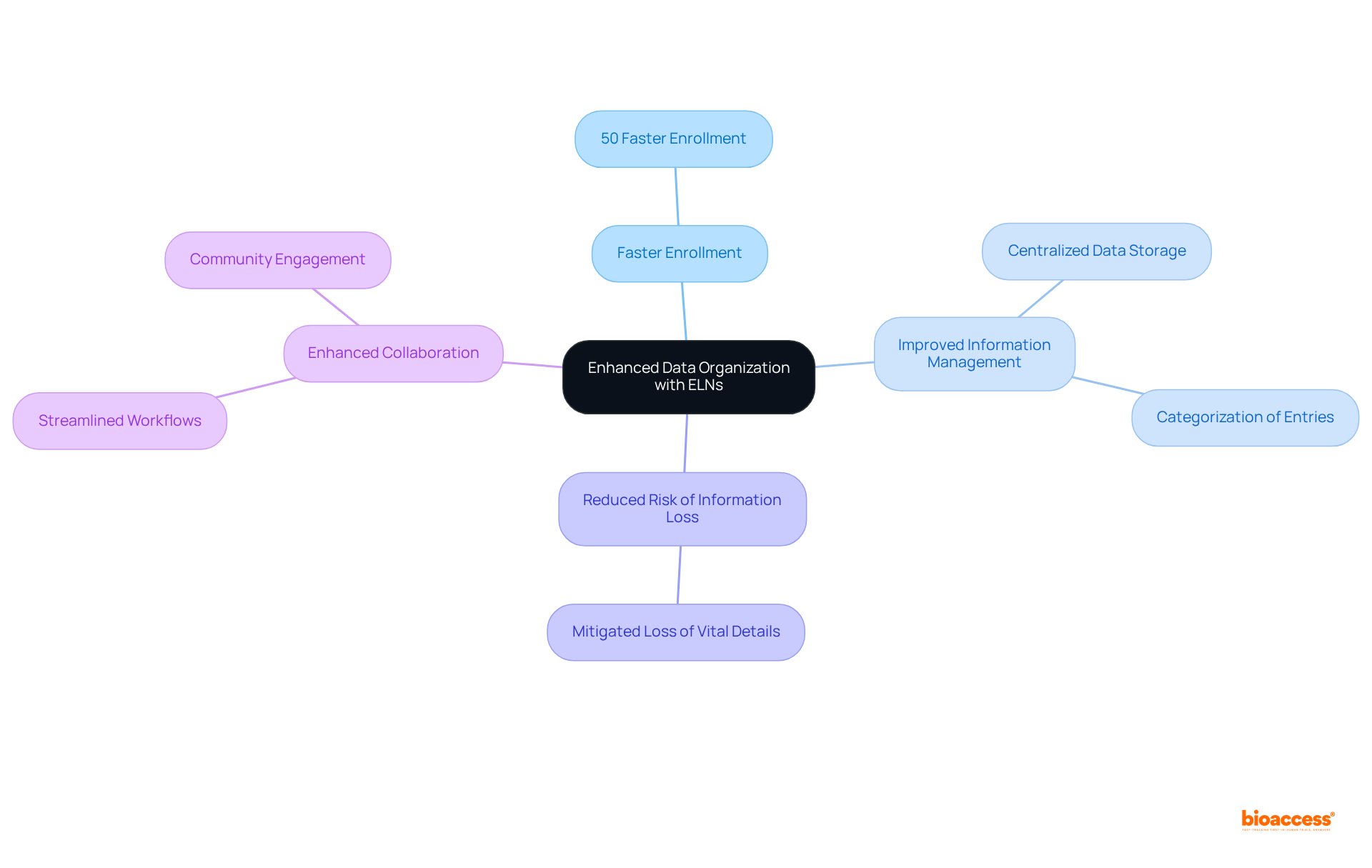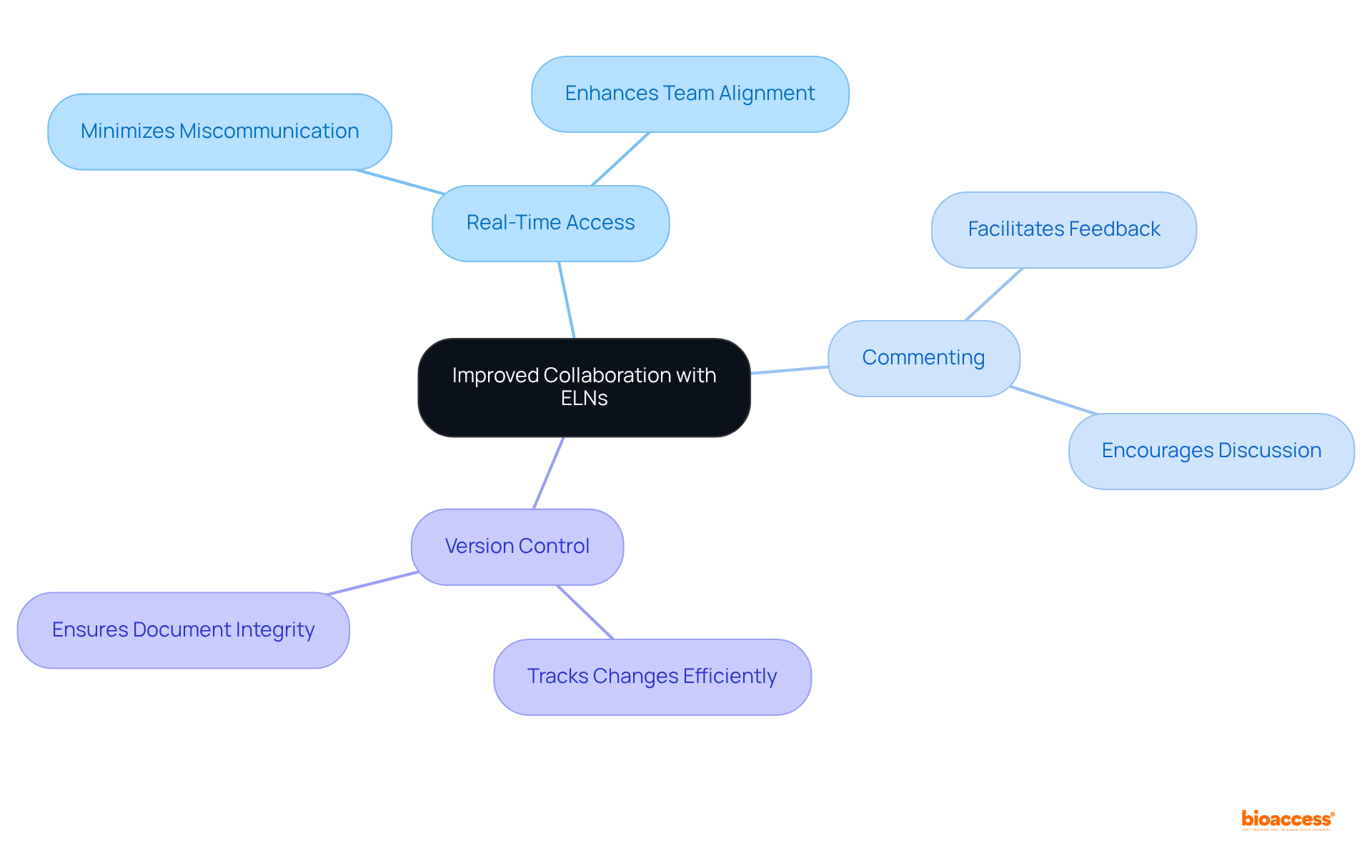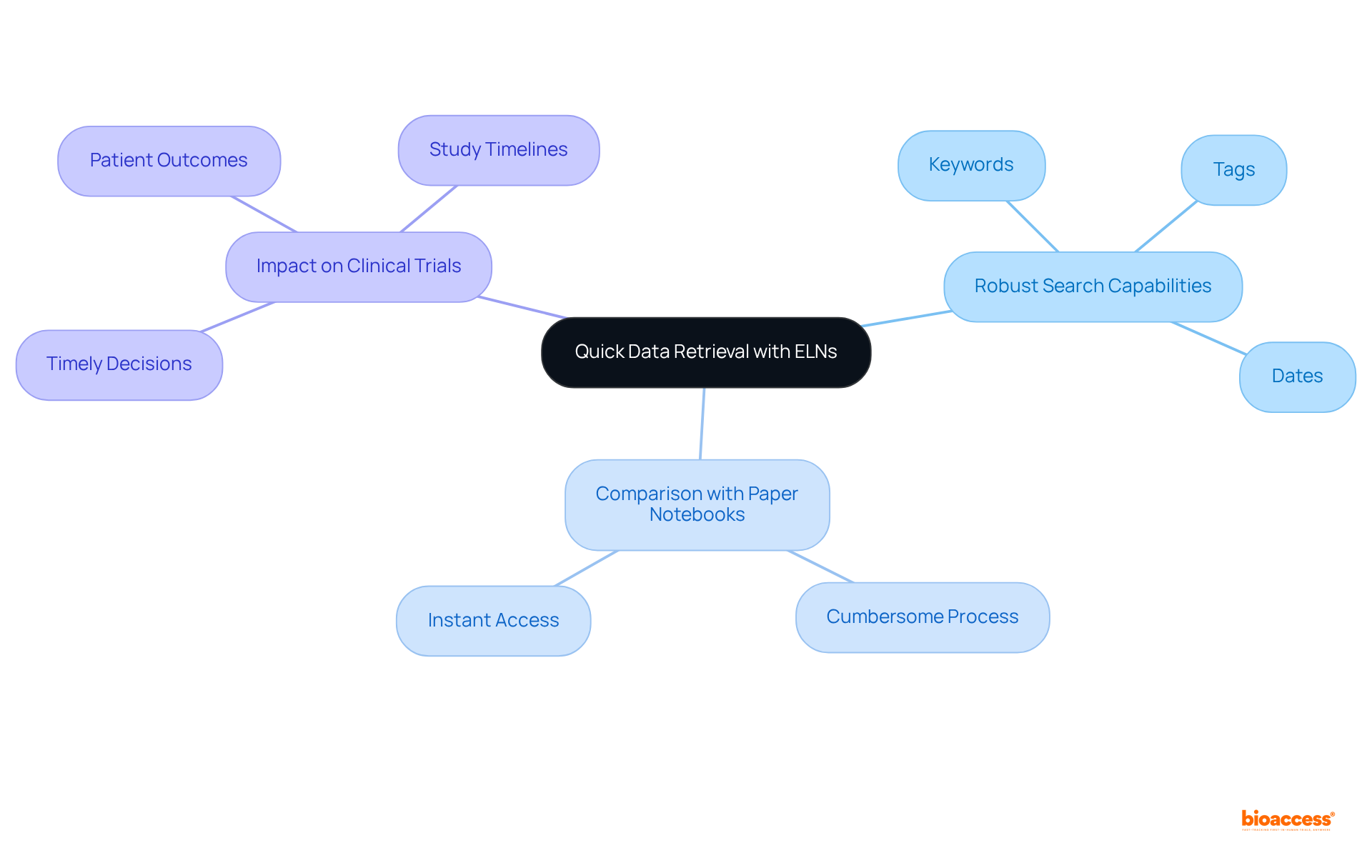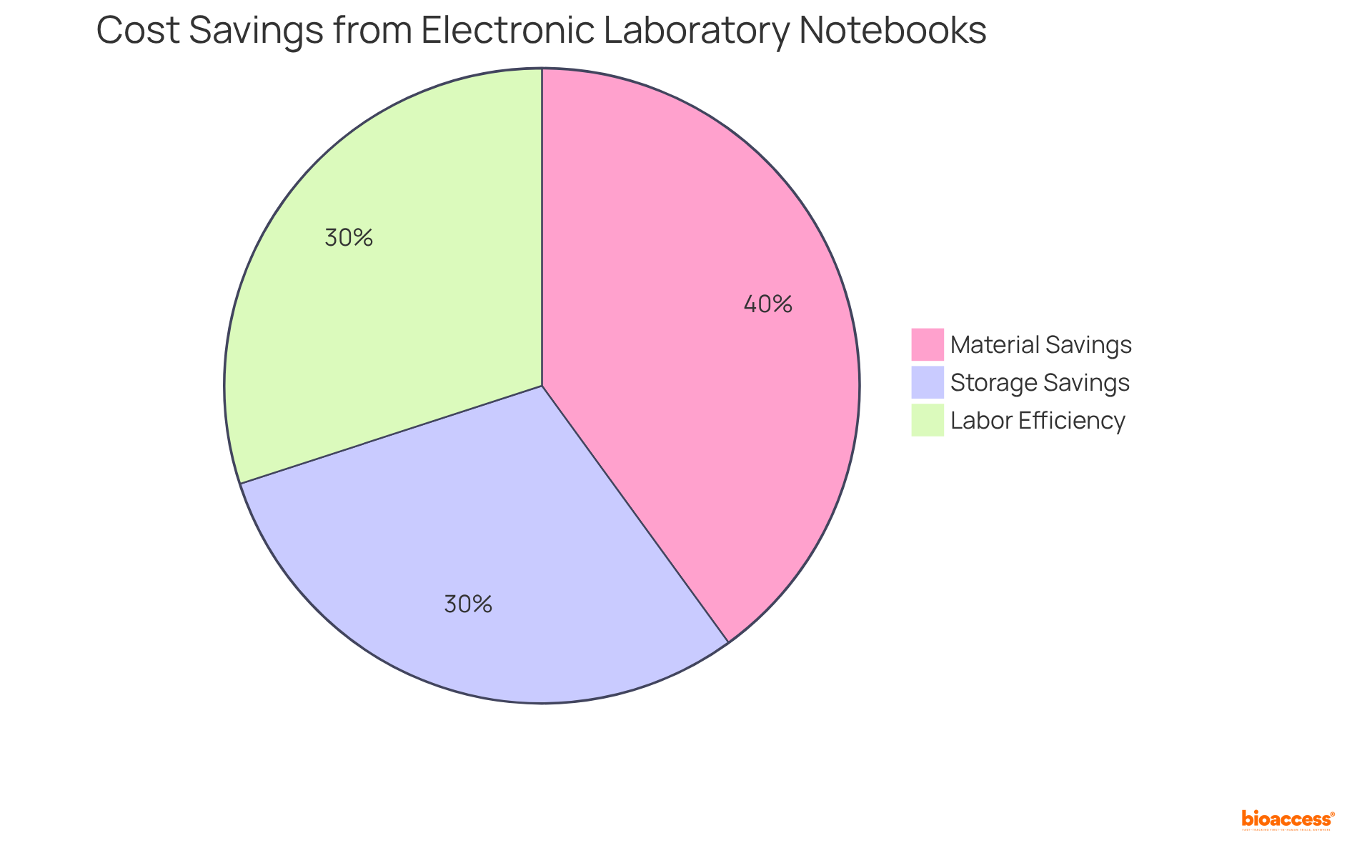


The article outlines ten key benefits of using electronic laboratory notebooks (ELNs) in research, emphasizing their pivotal role in enhancing efficiency, collaboration, data security, and regulatory compliance. Each benefit is substantiated by evidence that illustrates how ELNs streamline research processes, reduce operational costs, and facilitate real-time data access. Ultimately, these advantages lead to improved outcomes in clinical trials and medical studies, underscoring the critical importance of adopting ELNs in the evolving landscape of clinical research.
The landscape of clinical research is undergoing a significant transformation, driven by the rapid adoption of electronic laboratory notebooks (ELNs). These innovative tools are not merely digitizing traditional methods; they are revolutionizing data management, enhancing collaboration, and improving overall research efficiency.
As organizations like bioaccess® embrace ELNs, a critical question emerges: how can researchers fully leverage these technologies to maximize their impact on clinical trials and patient outcomes?
This article delves into the myriad benefits of using electronic laboratory notebooks, revealing how they can streamline processes, foster teamwork, and ultimately accelerate advancements in healthcare.
At bioaccess®, the adoption of electronic laboratory notebooks has fundamentally transformed methodologies in medical studies. This innovation enhances information gathering and management procedures, promoting faster ethical approvals and patient participation, which directly supports bioaccess®'s commitment to accelerating research in healthcare. The real-time data entry features of the electronic laboratory notebook empower researchers to swiftly access and analyze critical information, which is a necessity for fostering innovation in the Medtech, Biopharma, and Radiopharma sectors.
As the market for electronic lab notebooks is projected to expand significantly, achieving an estimated worth of USD 718.7 million by 2030, with the U.S. market valued at $156.9 million in 2024, the impact of these tools on trial efficiency is increasingly evident. Leaders in the Medtech sector recognize that an electronic laboratory notebook not only streamlines workflows but also enhances collaboration among study groups, ultimately yielding more efficient and timely results in trials. As Gary Guthart, CEO of Intuitive Surgical, remarked, 'The advancement of technology in medical studies is a masterclass in mission-driven innovation, long-term leadership, and relentless focus on medical impact.

The organization of information is revolutionized by electronic laboratory notebooks, which provide a centralized platform for storing experimental records, protocols, and notes. This structured approach significantly reduces the time scholars spend searching for information. Studies indicate that bioaccess® enables enrollment 50% faster than traditional methods, highlighting the effectiveness that electronic laboratory notebooks can bring to medical investigations. Electronic laboratory notebooks facilitate rapid access to specific information by allowing researchers to categorize their entries, which is crucial in clinical studies where accurate tracking is essential for compliance and reporting. Additionally, the risk of information loss is mitigated, ensuring that vital details remain readily available.
In the biopharma sector, the advantages of utilizing an electronic laboratory notebook extend to improved information management. They empower teams to maintain organized records that foster collaboration and streamline workflows. For instance, community engagement in clinical trials has been shown to boost participation rates, and similar principles apply to the use of electronic laboratory notebooks in enhancing information management. Overall, the use of electronic laboratory notebooks not only enhances information management but also contributes to more efficient and effective outcomes in research studies.

Electronic laboratory notebooks significantly enhance cooperation among research groups by allowing multiple individuals to access and modify documents simultaneously. This real-time collaboration ensures that all team members are aligned, minimizing miscommunication and boosting productivity. Features such as commenting and version control in an electronic laboratory notebook further enhance teamwork, allowing researchers to provide feedback and efficiently track changes. Such a collaborative environment is essential for bioaccess® as it engages with diverse stakeholders across various regions.

One of the primary advantages of utilizing an electronic laboratory notebook lies in the enhanced information security it provides. These notebooks typically feature:
These features effectively protect sensitive data from unauthorized access and potential breaches. By guaranteeing that only authorized individuals can access or modify information, electronic laboratory notebooks play a crucial role in maintaining the integrity of research findings and complying with regulatory standards. This aspect is especially vital for bioaccess®, which operates within highly regulated environments.

Electronic laboratory notebooks significantly enhance efficiency in investigations by automating repetitive tasks such as information entry and report creation. By leveraging features like customizable templates and pre-defined protocols, researchers can swiftly document their experiments, effectively reducing the necessity for extensive manual input. This automation not only mitigates the risk of human error but also empowers teams to concentrate on crucial aspects of their studies, thereby accelerating the pace of clinical trials using an electronic laboratory notebook.
Investigations have shown that electronic laboratory notebooks can reduce entry time by approximately 80%, culminating in a remarkable total of 3 million hours saved across scientific projects. Furthermore, electronic laboratory notebooks bolster information security and compliance, ensuring that sensitive data is protected while adhering to regulatory standards.
As a result, organizations like bioaccess® can secure ethical approvals in just 4-6 weeks and ensure enrollment is 50% faster than traditional markets, highlighting the profound impact of electronic laboratory notebooks on clinical research timelines.

Electronic laboratory notebooks (ELNs) provide robust search capabilities that empower researchers to access data instantly. In contrast to traditional paper notebooks, where locating specific entries can be a cumbersome process, the electronic laboratory notebook allows users to search by keywords, tags, or dates. This immediate access to information is crucial during clinical trials, where timely decisions significantly impact patient outcomes and study timelines. At bioaccess®, this functionality enhances the overall efficiency of scientific operations, demonstrating our commitment to advancing the Medtech landscape.

Adopting an electronic laboratory notebook can lead to substantial cost reductions for scientific institutions. By reducing the reliance on physical materials such as paper and storage, electronic laboratory notebooks significantly lower operational expenses. Moreover, the efficiency gained translates into reduced labor costs. For bioaccess®, these financial savings can be reinvested into further research and development, fostering innovation within the Medtech, Biopharma, and Radiopharma sectors.

Electronic laboratory notebooks play a crucial role in helping researchers effectively meet regulatory compliance requirements. Many of these electronic laboratory notebooks are equipped with features that facilitate adherence to regulations such as FDA 21 CFR Part 11, ensuring that all data is documented accurately and securely. By automating compliance-related tasks, the electronic laboratory notebook alleviates the burden on researchers, enabling bioaccess® to maintain high standards in clinical trials. This ultimately protects both patient safety and the integrity of information.

Electronic laboratory notebooks (ELNs) are designed to seamlessly integrate with a wide range of laboratory instruments and software, significantly enhancing the functionality and usability of electronic laboratory notebooks. This integration empowers researchers to optimize workflows by connecting information from diverse sources, including Laboratory Information Management Systems (LIMS) and analytical tools. Organizations that have adopted electronic laboratory notebooks report reductions in review cycle times by as much as 80%, illustrating the efficiency gained through these integrations. At bioaccess®, this capability ensures that all information is interconnected, facilitating improved analysis and supporting informed decision-making throughout the trial process.
Moreover, with 30% of specialists facing data quality issues due to integration challenges and 40% of healthcare providers encountering integration difficulties that impede care delivery and study timelines, the ability of electronic laboratory notebooks to interface with laboratory instruments is crucial in overcoming these obstacles and enhancing overall productivity in studies. Additionally, organizations are experiencing enhancements in programming efficiency by 90%, further highlighting the transformative impact of electronic laboratory notebooks in clinical research.

Electronic laboratory notebooks (ELNs) are designed to be scalable, allowing organizations to adapt to evolving requirements as they grow. This adaptability is crucial, whether it involves increasing the number of users or expanding data storage capacity; ELNs can seamlessly accommodate these changes without sacrificing performance. Such scalability proves especially advantageous for bioaccess®, which operates in dynamic environments and must swiftly respond to new research opportunities and challenges. By leveraging the flexibility of electronic laboratory notebooks, organizations can enhance their research capabilities and maintain a competitive edge in the ever-evolving Medtech landscape.

The integration of electronic laboratory notebooks (ELNs) into research practices signifies a pivotal advancement in the recording, organization, and utilization of scientific data. By enhancing data management, fostering collaboration, and ensuring compliance with regulatory standards, ELNs are transforming the clinical research landscape, rendering it more efficient and effective.
The key benefits of ELNs include:
Furthermore, the time efficiency gained from automating repetitive tasks and the cost-effectiveness achieved by minimizing reliance on physical materials further highlight the transformative impact of ELNs. With capabilities that support rapid data retrieval and scalability, organizations can adapt their research methodologies to meet evolving demands and maintain a competitive edge.
As the reliance on electronic laboratory notebooks continues to expand, the importance of these tools in accelerating clinical research is undeniable. Embracing ELNs not only boosts operational efficiency but also cultivates a culture of innovation and collaboration within research teams. The future of scientific inquiry rests on leveraging these advanced tools to propel breakthroughs in healthcare and beyond.
What is bioaccess® and how does it utilize electronic laboratory notebooks?
bioaccess® is an organization that has transformed methodologies in medical studies through the adoption of electronic laboratory notebooks (ELNs). This innovation enhances information gathering and management, promoting faster ethical approvals and patient participation, thereby accelerating research in healthcare.
What are the benefits of using electronic laboratory notebooks in clinical research?
Electronic laboratory notebooks improve data organization, streamline workflows, enhance collaboration among study groups, and allow for real-time data entry. This results in faster access to critical information, reduced time spent searching for data, and improved trial efficiency.
How do electronic laboratory notebooks impact the speed of clinical trial enrollment?
Studies indicate that bioaccess® enables enrollment in clinical trials 50% faster than traditional methods, showcasing the effectiveness of electronic laboratory notebooks in medical investigations.
What is the projected market growth for electronic laboratory notebooks?
The market for electronic laboratory notebooks is projected to expand significantly, reaching an estimated worth of USD 718.7 million by 2030, with the U.S. market valued at $156.9 million in 2024.
How do electronic laboratory notebooks enhance collaboration among research teams?
Electronic laboratory notebooks allow multiple individuals to access and modify documents simultaneously, fostering real-time collaboration. Features like commenting and version control help minimize miscommunication and improve productivity.
What are the advantages of improved information management with electronic laboratory notebooks?
Improved information management with electronic laboratory notebooks leads to better organization of records, reduced risk of information loss, and enhanced collaboration, all of which contribute to more efficient and effective outcomes in research studies.